General & Preventative Dentistry
You've no doubt heard it said that an ounce of prevention is worth a pound of cure. In dentistry, you might say it's worth two pounds. Maybe even thousands of dollars. That's because dental problems can become exponentially more expensive — and painful — the longer they go unaddressed. Fortunately, modern dentistry has many easy and relatively inexpensive ways to make sure that today's minor annoyance does not turn into tomorrow's major headache.
Preventive dentistry describes all the procedures used to arrest tooth decay and other diseases in the earliest stages. The goal is to keep you as healthy as possible and maintain your natural teeth for life.
Preventive Dentistry Procedures
Preventive dentistry procedures range from the most basic services that have been used successfully for decades, to recent technological innovations. These procedures include:
- Cleanings. This is where dental health starts. There's just no substitute for physically removing disease-causing dental plaque and calculus (tartar) from your teeth — especially in hard-to-reach areas near the gum line. That's why regular professional cleanings are so important to your health.
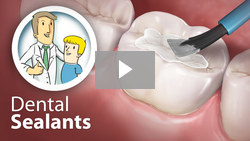 Dental Sealants. These invisible plastic coatings fill the tiny grooves in back teeth so they do not become havens for bacteria. They prevent cavities from forming and the need for fillings later on.
Dental Sealants. These invisible plastic coatings fill the tiny grooves in back teeth so they do not become havens for bacteria. They prevent cavities from forming and the need for fillings later on.- Fluoride. This mineral is readily incorporated into the teeth's mineral structure, thereby making them stronger and more decay-resistant. Fluoride can even reverse tiny cavities that are starting to form. If you are not getting enough from your toothpaste and drinking water, it can be applied directly to your teeth at the dental office.
- Mouthguards. Athletic mouthguards are designed to absorb and distribute the forces of impact and minimize traumatic injury to both the hard and soft tissues of the mouth. In fact, an athlete is 60 times more likely to suffer harm to teeth when not wearing a mouthguard. The best ones are custom-made for you by your dentist.
 Oral Cancer Screenings. Your best chance of surviving oral cancer — a disease that affects not only lifelong smokers but also young non-smokers — is early detection and treatment. Oral cancer screenings are a routine part of every regular dental exam.
Oral Cancer Screenings. Your best chance of surviving oral cancer — a disease that affects not only lifelong smokers but also young non-smokers — is early detection and treatment. Oral cancer screenings are a routine part of every regular dental exam.- Salivary Diagnostics. This is an exciting new development in the field of preventive dentistry. While it is in its infancy, it is already possible to detect the presence of certain diseases with a salvia test, and the technology is developing rapidly.
- X-Rays. For around a century, dentists have been using x-rays to reveal signs of disease not visible to the naked eye. Now, with CAT scans, they have become three-dimensional and are an indispensable tool to diagnose tooth decay, gum disease, bone density, bone volume and tumors.
Your Role in Preventing Dental Disease
There's one more extremely important component of preventive dentistry: you. The procedures mentioned above can only be effective if you come in to the dental office to take advantage of them. Likewise, the importance of maintaining a good oral hygiene routine at home cannot be overstated. Daily effective brushing and flossing will go a long way toward removing the dental plaque responsible for dental disease, tooth loss, and the need for more complex dental treatment.
Children's Dentistry
Your child won't keep his or her first teeth forever, but that doesn't mean those tiny pearly whites don't need conscientious care. Maintaining your child's dental health now will provide health benefits well into adulthood, as primary (baby) teeth serve some extremely important functions.
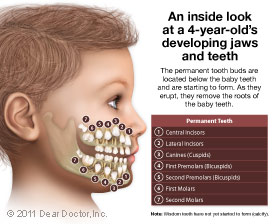
For one thing, primary teeth serve as guides for the eruption of permanent (adult) teeth, holding the space into which these new teeth will erupt. The crowns (tops) of the permanent teeth actually push against the roots of the baby teeth, causing them to resorb, or melt away. In this way, the adult teeth can take their proper place.
What's more, your child's primary teeth will be there for most of childhood, helping your child to bite, chew and speak. For the first six or so years, he or she will be relying on primary teeth exclusively to perform these important functions. Until around age 12, your child will have a mix of primary and permanent teeth. You will want to make sure those teeth stay healthy and are lost naturally — when it's time.
Your Child's First Teeth
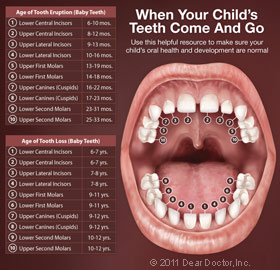
Your child's 20 baby teeth will begin to appear usually between six and nine months, though in some cases it may start as early as three months or as late as twelve months. The two lower front teeth tend to erupt first, followed by the two upper ones. The first molars come in next, followed by the canines (eyeteeth). Sometimes your baby can experience teething discomfort during this process. If so, let us know and we will advise you as to the best course of action.
Your infant's gums and newly erupting teeth should be gently wiped after each feeding with a water-soaked gauze pad or damp washcloth. Starting at age 2, when there are more teeth in the mouth, establish a daily brushing routine with a small, soft-bristled toothbrush and no more than a thin smear of fluoridated toothpaste. Your child may need your help with this important task until about the age of 6.
Your Child's First Dental Appointment
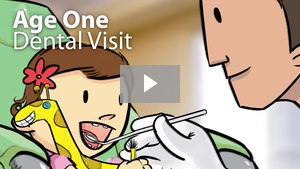
The American Academy of Pediatric Dentistry recommends that you bring your child in to see us by his/her first birthday. Though this may sound early, we can teach you proper pediatric oral hygiene techniques, check for cavities, and watch for developmental problems.
There are a number of forms of tooth decay that can affect babies and small children. Early Childhood Caries (tooth decay) can develop rapidly, progressing from the hard, outer enamel layer of a tooth into the softer, inner dentin in six months or less.
Most of all, we want to make sure your child has a positive experience at our office and will be a regular visitor for years to come.
Pediatric Dental Treatments
There are a variety of dental treatments we provide to prevent tooth decay in children, or to save or repair teeth when necessary. They include:
Topical Fluoride — Fluoride incorporates into the enamel of teeth, making it harder and more resistant to decay. Although there is a small amount of fluoride in toothpastes and in some drinking water supplies, we can apply a higher concentration onto your child's teeth for maximum protection (Watch Preventing Cavities in Kids Video).
Dental Sealants — We can apply a plastic coating that prevents cavities by sealing the little grooves on the chewing surfaces of back teeth known as "pits and fissures." These little crevices become the perfect environments for decay-causing bacteria. Immature tooth enamel is more permeable and therefore less resistant to tooth decay. Dental sealants are easy to apply and provide years of protection (Watch Dental Sealant Video).
Root Canal Treatment — Perhaps you have had a root canal treatment yourself, to save an injured or severely decayed tooth. Well, sometimes children need root canals, too. As mentioned above, baby teeth are important guides to the permanent teeth that are already forming beneath your child's gums. Therefore, saving them from premature loss can help prevent a malocclusion ("mal" - bad; "occlusion" - bite) that requires orthodontic treatment.
Bonding — Chips and minor fractures to front teeth — common childhood occurrences — can be repaired with tooth-colored bonding materials. These lifelike resins made of plastic and glass can be used on baby teeth as well as permanent teeth and last until the youngster has completed facial growth (Watch Dental Bonding Video).
Orthodontic Concerns
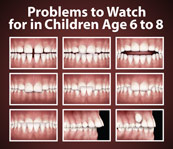
By around age 7, most malocclusions have become evident. Interceptive orthodontic treatment around this time can help direct proper tooth positioning and/or jaw growth, eliminating or simplifying the need for later treatment. There are many orthodontic problems that can be detected early and are examples of why a trained professional should evaluate your child during his/her growth and development.
Sports & Your Child's Teeth
If your child is active in sports, we highly recommend a custom-made mouthguard. According to the American Dental Association, an athlete is 60 times more likely to suffer dental harm when not wearing one of these protective devices. We can have a mouthguard custom-made specifically for your child using a model of his or her teeth that will offer greater protection than an off-the-shelf model. It's an investment that pays off highly in the form of reduced pain, suffering — and dental expenses down the road! Please ask us about mouthguards at your child's next appointment.
Cosmetic Dentistry
It's impossible to overstate the emotional, social and even professional benefits that smiling with confidence can give you. If you find you cover your mouth when you smile, or even hold back your smile because you don't want to show your teeth, you should consider what cosmetic dentistry — the art of smile enhancement — can do for you.
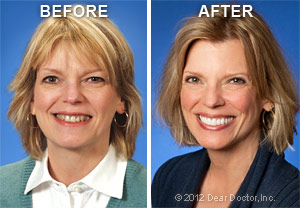
There's so much that can be done these days to improve the appearance of a person's smile — at any age. From powerful, professional whitening treatments to amazingly realistic porcelain veneers to state-of-the-art dental implants, there's a wide range of exciting possibilities.
The first step in any smile makeover is a thorough dental examination to make sure that your cosmetic problems really are just that, and not a sign of underlying dental disease. Once your health has been established, your smile can be cosmetically enhanced in a variety of ways.
Cosmetic Dentistry Procedures
A successful smile makeover is a team effort between you and the dentists who treat you. Depending on which procedures you choose, other highly skilled professionals such as dental lab technicians may also play a crucial role. Some common cosmetic dentistry procedures include:
- Cosmetic Bonding, to repair small chips or cracks (Watch Video)
- Crowns & Bridgework, to replace large amounts of lost tooth structure and/or missing teeth (Watch Video)
- Dental Implants, for the longest-lasting tooth replacement available today (Watch Video)
- Inlays & Onlays, to fill teeth with larger cavities (Watch Video)
- Invisalign Clear Aligners, for highly discreet orthodontic treatment (Watch Video)
- Orthodontic Treatment, to move teeth into the right position (Watch Video)
- Porcelain Veneers, for repairing larger chips and cracks, and reshaping teeth (Watch Video)
- Removable Dentures, to help you smile again (Watch Video)
- Teeth Whitening, to brighten a faded or discolored smile (Watch Video)
- Tooth-Colored Fillings, for a completely natural, healthy look (Watch Video)
Your Smile Makeover
The most important job you have as a member of your own smile makeover team is to communicate exactly what you don't like about your smile and how you'd like it to be different. Before the first consultation, give some thought to the following questions:
- What do you like or dislike about the color, size, shape and spacing of your teeth?
- Are you pleased with how much your teeth show, both when you smile and when your lips are relaxed?
- Do you want teeth that are perfectly aligned and a bright "Hollywood White," or would you prefer a more natural look with slight color, shape and shade variations?
- Would you like more or less of your gums to show when you smile?
It is extremely helpful for you to bring in pictures you have collected — of smiles you like, smiles you don't like, and/or photos of the way your own smile used to look, if that's the result you're aiming for. Now is the time to get started on creating a smile that will make you feel as good as you look!
